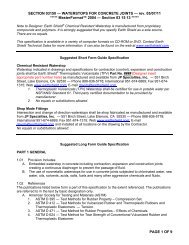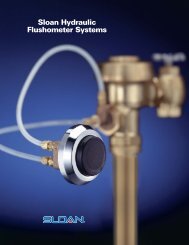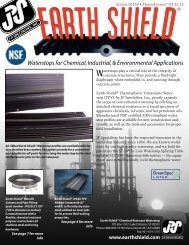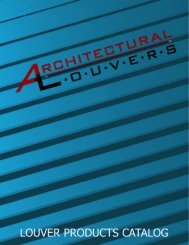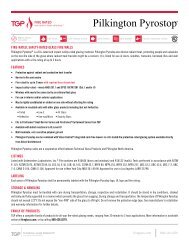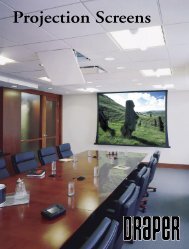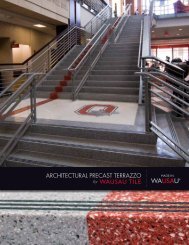National Gypsum Construction Guide
National Gypsum Construction Guide The entire - AECinfo.com
National Gypsum Construction Guide The entire - AECinfo.com
- No tags were found...
Create successful ePaper yourself
Turn your PDF publications into a flip-book with our unique Google optimized e-Paper software.
Gold Bond ® BRAND Foil Back Wallboard<br />
DESCRIPTION<br />
Gold Bond ® Foil Back Wallboard<br />
boards consist of a fireresistive<br />
gypsum core<br />
encased in heavy naturalfinish<br />
paper on the face side<br />
and strong liner paper on the<br />
backside to which aluminum<br />
foil is laminated. The ends<br />
are square cut and finished<br />
smooth.<br />
BASIC USES<br />
Foil Back Wallboard can be used<br />
for exterior walls and ceilings<br />
in new construction and<br />
remodeling. The aluminum<br />
foil, laminated to the back<br />
surface, is a vapor retarder to<br />
keep interior moisture within<br />
the building at a suitable<br />
comfort level. For use with<br />
furred masonry, wood or steel<br />
framing, Gold Bond Foil Back<br />
Wallboard is effective for<br />
single-layer applications and<br />
as a base layer in doublelayer<br />
applications where a<br />
vapor retarder of 1.0 perm or<br />
less is required.<br />
ADVANTAGES<br />
1. In tests conducted according<br />
to ASTM Test Procedure E 96<br />
(desiccant method), 1/2" Foil<br />
Back Wallboard showed a<br />
performance of 0.06 perm<br />
compared to 34.2 perm for<br />
1/2" regular gypsum<br />
wallboard and 28.4 perm for<br />
1/2" gypsum wallboard with<br />
two coats of flat latex paint.<br />
2. In-place cost of Foil Back<br />
Wallboard installation is<br />
lower per thousand sq. ft.<br />
than a similar installation for<br />
regular gypsum wallboard<br />
and polyethylene-film retarder<br />
installed separately.<br />
3. Easy-to-handle Foil Back<br />
Wallboard is adaptable to<br />
virtually all exterior wall and<br />
ceiling construction: wood<br />
frame, furred masonry.<br />
LIMITATIONS<br />
1. Not recommended for<br />
use where exposure to<br />
moisture and high outside<br />
temperature is extreme and<br />
continuous. Under these<br />
conditions, a qualified<br />
mechancial engineer<br />
should determine location<br />
of the vapor retarder.<br />
2. Not to be used as a base for<br />
ceramic or other tile or as a<br />
base layer for prefinished<br />
vinyl wall boards in doublelayer<br />
assemblies. Also, not<br />
to be used as a base for<br />
adhesively applied vinyl or<br />
other highly water-vaporresistant<br />
wall coverings.<br />
3. To prevent objectionable<br />
sag in ceilings, weight of<br />
overlaid unsupported<br />
insulation should not exceed:<br />
1.3 lb./sq. ft. for 1/2" thick<br />
boards with frame spacing<br />
24" o.c.; 2.2 lb./sq. ft. for<br />
boards with frame spacing<br />
16" o.c. Boards 3/8" thick<br />
must not be overlaid with<br />
unsupported insulation.<br />
Unheated attic spaces should<br />
be properly ventilated.<br />
4. Foil Back <strong>Gypsum</strong> Wallboard<br />
is not recommended for use<br />
in hot, humid, climates such<br />
as the Southern Atlantic and<br />
Gulf Coast areas.<br />
MATERIALS<br />
Manufactured boards with<br />
gypsum core, paper-encased<br />
with aluminum foil<br />
laminated backing.<br />
SIZES AND TYPES<br />
Thickness Width Length<br />
1/2" 4' 6' to 16'<br />
3/8" 4' 6' to 16'<br />
5/8" 4' 6' to 16'<br />
Edges: Square, tapered or<br />
Sta-Smooth.<br />
APPLICABLE STANDARDS<br />
ASTM C 36/C 1396<br />
TECHNICAL DATA<br />
SURFACE BURNING<br />
CHARACTERISTICS<br />
(ASTM E 84)<br />
Flame spread: 15<br />
Smoke developed: 0<br />
FIRE RESISTANCE RATINGS<br />
Foil Back Wallboard has not<br />
been used in fire resistance<br />
tests. Fire resistance ratings<br />
represent the results of tests<br />
on assemblies made up of<br />
specific materials in a<br />
specific configuration.<br />
When selecting<br />
construction designs to<br />
meet certain fire resistance<br />
requirements, caution must<br />
be used to ensure that each<br />
component of the assembly<br />
is the one specified in the<br />
test. Further, precaution<br />
should be taken that<br />
assembly procedures are in<br />
accordance with that of the<br />
tested assembly. (For<br />
copies of specific tests,<br />
call 1-800-NATIONAL or<br />
1-800-628-4662.)<br />
RECOMMENDATIONS<br />
Examine and inspect materials<br />
to which gypsum board is<br />
to be applied. Remedy all<br />
defects prior to installation<br />
of <strong>Gypsum</strong> Board. Any<br />
defects in the finished<br />
installation due to<br />
misaligned framing or<br />
other cause will be the<br />
responsibility of the work<br />
performed under that<br />
section of the specification<br />
and such defects shall be<br />
remedied under that<br />
secton of the specification<br />
<strong>Gypsum</strong> wallboard should be<br />
applied first to ceiling at<br />
right angles to framing<br />
members, then to walls.<br />
Boards of maximum<br />
practical length should be<br />
used so that an absolute<br />
minimum number of end<br />
joints occur. Board edges<br />
should be brought into<br />
contact with each other but<br />
should not be forced into<br />
place.<br />
Wallboard joints at openings<br />
should be located so that<br />
no end joint will align with<br />
edges of openings unless<br />
control joints will be<br />
installed at these points.<br />
End joints should be<br />
staggered, and joints on<br />
opposite sides of a partition<br />
should not occur on the<br />
same stud.<br />
<strong>Gypsum</strong> wallboard should be<br />
held in firm contact with<br />
the framing member while<br />
fasteners are being driven.<br />
Fastening should proceed<br />
from center portion of the<br />
wallboard toward the edges<br />
and ends. Fasteners should<br />
be set with the heads<br />
slightly below the surface<br />
of the wallboard in a<br />
dimple formed by the<br />
hammer or power<br />
screwdriver. Care should<br />
be taken to avoid breaking<br />
the face paper of the<br />
wallboard. Improperly<br />
driven nails or screws shall<br />
be removed.<br />
For best painting results, all<br />
interior surfaces, including<br />
joint compound, should be<br />
clean, dust-free and not<br />
glossy. To improve fastener<br />
and joint concealment, a<br />
prime coat of drywall<br />
primer is recommended to<br />
equalize the porosities<br />
between surface paper and<br />
joint compound.<br />
See page 61, Environmental<br />
Conditions and Limitations.<br />
86 NATIONAL GYPSUM WALLBOARD PRODUCTS



